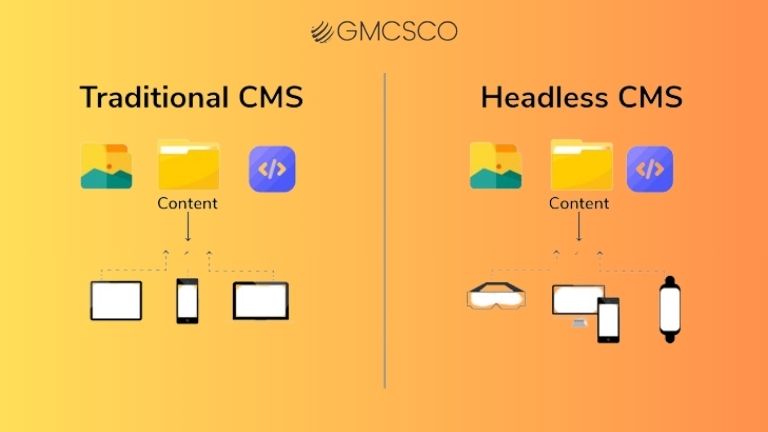
Content Management Systems (CMS) enable users to develop websites and manage content as per their requirement. Over time, more specific requirements resulted in advancement of CMS platforms. Present CMS platforms can be bifurcated into two major categories: Traditional CMS and Headless CMS — each with their own set of unique advantages and disadvantages. The decision to ascertain which one of the two will be appropriate for your website development needs is a function of its objective, size, scope and complexity of operations.
Traditional CMS:
Traditional CMS platforms are one of the earliest developed CMS platforms, and hence are straightforward and easy to use by nature. Given that website complexity increased with time, Traditional CMS platforms are well-suited for informative websites with simple uniform layouts. Most commonly used Traditional CMS platforms include the widely used WordPress, Joomla, and Drupal. Their all-in-one projection of designing, creating and managing design, storage and delivery make them the most frequently used platforms for website development.
Advantages:
- Ease of use: The biggest advantage of Traditional CMS platforms is their user-friendly interfaces and simplicity making them the most preferred CMS options for users across all skill levels. They provide a “What You See Is What You Get” (WYSIWYG) editor that makes content creation, editing, and publishing extremely simple.
- Multiple In-Built Functionalities: Traditional CMS platforms come as prepackaged tools that include several in-built features that further simplify website development and management. They need minimal customization making them easy to use for those without any development background. Some of such in-built functionalities include user management, SEO tools, themes, and plugins for user-friendly websites.
- Rapid Deployment: Traditional CMS platforms make it extremely efficient to create and launch websites. The vast number of pre-built templates and plugins simplify faster addition of desired functionalities. Hence, they are the most preferred option for smaller, less complex projects, especially with strict deadlines.
Disadvantages:
- Monolithic Architecture: Traditional CMS platforms are usually monolithic in nature – meaning the frontend presentation layer is tightly coupled with the backend CMS. This makes it difficult to incorporate custom designs and complex user interfaces, limiting the flexibility and customizability of traditional CMS.
- Performance Issues: With Monolithic architecture also comes the integrated nature of traditional CMS platforms. As website complexities and scale increase, these can sometimes lead to performance issues. With integrations come heavy codebases and a vast number of plugins which result in slow page load times and create performance optimization challenges.
Headless CMS:
Headless CMS are different from traditional CMS in the sense that they decouple (separate) the content management backend from the frontend presentation layer. This separation enables website developers to use their preferred programming frontend frameworks (eg. React, Vue.js, Angular, etc) to pull content via Application Programming Interfaces (APIs). This enables headless CMS to provide much greater flexibility and control over the website’s user interface (UI) and user experience (UX).
Advantages:
- Customization and Flexibility: Website developers have complete control over the frontend presentation layer in a headless CMS. This enables them to create highly customized and tailored user experiences. Such flexibility is extremely beneficial for websites with custom design requirements or highly complex interactive elements.
- Improved Performance: Eliminating the monolithic architecture of traditional CMS platforms, headless CMS enables content optimization independent of the frontend code. This enables headless CMS to deliver much better performance in terms of faster page load times and improved scalability, specifically in the case of content-heavy sites or applications.
- Scalable: Headless CMS platforms are much more adaptive to latest technologies since they separate frontend and content environments. Front-end environments are in a constant state of evolution providing developers with the freedom to choose desired frontend and backend technologies that are best suited for custom requirements without being tied down to the limitations of traditional CMS platforms.
Disadvantages:
- Constant Skill Upgradation: As headless CMS support different frontend development frameworks, the developers need to be ready to be in a constant state of skill refresh and upgrade. They need to continuously learn new technologies to understand and implement them to provide the desired results. They need to be well-versed with frontend development technologies and APIs to utilize headless CMS platforms effectively.
- Complex Development: Since the content management backend is separate from the frontend presentation layer, the development process become extremely complex. This requires developers to develop and maintain both these components separately increasing the overall efforts leading to longer development cycles, delayed deployment and higher costs. This is one of the biggest contributors to smaller projects/websites with limited budgets/developers losing their interest in Headless CMS. Oftentimes such project end up causing significant wastage of time and effort with the biggest loss being the objective completely unmet.
So Which CMS is apt for Your Requirements?
Suitability of Traditional CMS or Headless CMS depends completely upon the specific requirements and goals that you intend to achieve with your website. Following are a few key factors that you may consider while choosing the apt CMS for your requirements:
- Website Objective and Complexity: Traditional CMS with simple straightforward functionality are apt for simple websites or blogs that have been developed for informative purposes with regular content creation and management requirements. Headless CMS platforms are more suited for complex projects that need highly customized user experiences and interactive applications as it offers greater control and flexibility.
- Expertise of your Development Team: You must go for Headless CMS platforms if your core tech and development team comprises highly skilled frontend technologies developers proficient in the latest programming languages such as JavaScript, Python, etc. On the other hand, if your team’s technical prowess is centered around traditional programming languages such as PHP, opting for a Traditional CMS platform with a familiar technology stack will be a much more practical approach. It is always better to let your core team work with comfortable technologies than completely change the technology and expect/force them to revamp their technical skills on the fly.
- Scalability: When rapid scalability is priority, headless CMS platforms must be your preferred choice. On the other hand, traditional CMS platforms will be sufficient for smaller projects that are not meant to grow exponentially.
- Performance: Informative websites with lower traffic volumes where website performance is not directly related to profitability must go for Traditional CMS. E-commerce websites and other high performance websites that have significant traffic such as social media platforms must go for Headless CMS.
Traditional CMS and Headless CMS both have their distinct advantages and disadvantages. What you should go for depends purely on your website’s needs, your scalability requirements, your team’s comfort ability with latest technologies, and your budget.
Also Read About:

